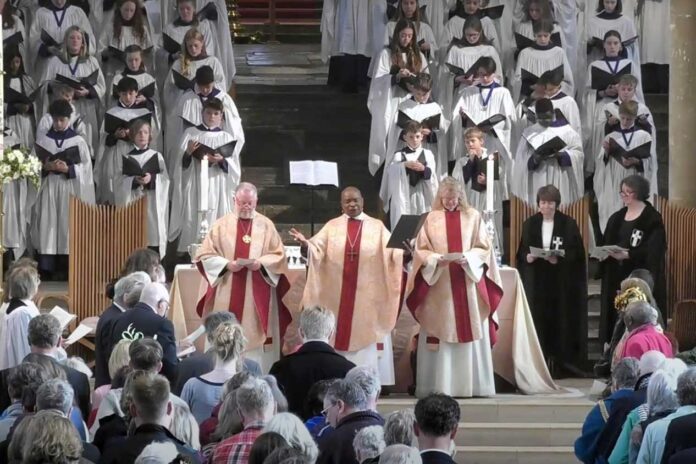(RNS) — Easter Sunday is one of the rare days of the church year when the archbishop of Canterbury preaches at the main service of the day at the neo-Gothic Canterbury cathedral, speaking as head of the Church of England and the first prelate among equals in the worldwide Anglican Communion.
Not this year. Four months after the Rt. Rev. Justin Welby stepped down and six months after he tendered his resignation for failing to do enough to report a known child abuser, there is no sign of a successor. Indeed, the Catholic hierarchy is likely to name a new pope before Anglican leaders manage to issue a job description for Welby’s replacement. One indication of how complicated the process of replacing him is: Lord Evans, the man heading the effort, is a former head of MI5, the British equivalent of homeland security secretary.
RELATED: Pope Francis, Charismatic Reformer and Disruptor, Dies at 88
As Bishop Rose Hudson-Wilkin, the bishop of Dover, offered the good news of the Resurrection at Canterbury — and to the nation, as BBC broadcast the Easter service live — conversations in the pews likely strayed on Easter to the extended search for a replacement for Hudson-Wilkin’s former boss, and the church’s struggle to fill other prominent bishoprics. (Locals were also bound to be talking about the financial struggles of their parishes: Under pressure to send substantial sums to their dioceses, many are fighting to keep their own doors open as repairs to many of their ancient, beautiful buildings eat up money.)
Despite these challenges, Lord Evans and the Canterbury search committee are mindful that the new archbishop will not only need to lead the British church, but play a significant role in the Anglican Communion. For the first time, the Canterbury Crown Nominations Commission will include five international Communion representatives.
But as of Good Friday, none of the Anglican Communion reps have been named. Nor have committee members from the Church of England’s General Synod, nor those from the Diocese of Canterbury members selected from the diocese’s Vacancy in See Committee, which itself has become embroiled in legal battles over whom to send.
Canterbury Cathedral in Canterbury, Kent, England. (Photo by Rafa Esteve/Wikimedia/Creative Commons)
Conservatives believe that the Vacancy in See Committee has been formed in such a way that it favors church liberals, while liberals accuse conservatives of slow-walking the filling of critical episcopal vacancies by refusing to back candidates they consider not orthodox enough on sexuality. The stakes in the decision to replace Welby are much higher. “When the prize is appointing the Archbishop of Canterbury, is it such a stretch,” said Tim Wyatt, a leading commentator on the Church of England via his Substack, “The Critical Friend,” “to imagine your devious opponents might also stoop to stitching up the complicated procedures?”
According to Wyatt, “The conspiracy theorists are out in force.”
The divisions were especially evident during Holy Week, the most sacred time in the church calendar as Christians prepare for Easter Day. Across the United Kingdom, bishops customarily preside at a Chrism Mass, at which special oils used in rituals from baptisms to last rites are blessed and priests renew their ordination vows.
But in London, a separate Chrism Mass was held for clergy who don’t accept women as priests or bishops – 31 years after women’s ordination was first introduced, and in a diocese whose bishop is a woman. Some parishes belonging to the church’s evangelical wing offer alternatives to Chrism Masses for those who object to the way the church is changing.
In the past, the selection of an archbishop of Canterbury preserved the peace alternating between the evangelical and Anglo-Catholic wings of the church. After George Carey (1991-2002), an evangelical, came Rowan Williams (2002-12), Anglo-Catholic; then Welby, evangelical. At one time, money would have been put on Graham Usher, bishop of Norwich, to claim the post, but he has now been elected to the Crowns Nominations Commission for Canterbury, which would seem to rule him out.

Archbishop of Canterbury Justin Welby conducts a church service with Anglicans in Harare, Zimbabwe, April, 17, 2016. (AP Photo/Tsvangirayi Mukwazhi, File)
An intriguing candidate would be Guli Francis-Dehqani, bishop of Chelmsford. Hers is not a high-profile diocese, but Francis-Dehqani, the daughter of a former Anglican bishop of Iran whose family came to the U.K. as refugees in the 1980s, has been impressive in speaking for the Church of England on housing. Francis-Dehqani has also managed to avoid becoming part of Welbyism — a pejorative for those obsessed with making the church more corporate. But is the Church of England — or the wider Anglican Communion — ready for a woman in the top job?


